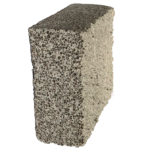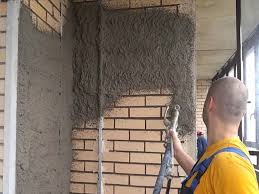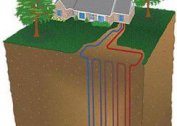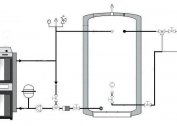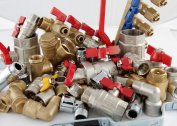A change in the traditional composition of the cement-sand mortar led to the production of warm plaster. A mineral or organic filler is added to the mixture, increasing its heat-insulating properties. Porous structure components are used. The presence of air in the pores reduces the coefficient of thermal conductivity. Warm plaster is used in the decoration of facades and interior work.
Types of Warm Plaster
Insulating plaster is classified by type of filler. Among the most popular types:
- Expanded vermiculite - a mineral filler obtained by heat treatment of rocks. Feature of the composition are excellent antiseptic characteristics. The mortar is ideal for plastering the facade. The protective layer reliably protects the wall from the cold. The temperature drops, wind.
- Polystyrene granules - light foam balls are filled with air, so they become a barrier to heat loss. The mixture absorbs water little, affordable. A significant drawback is the lack of strength of the layer. Finishing is required. Also on the downside include the combustibility of the filler.
- Sawdust - sawdust, clay or paper is added to the mixture as an additive. The plaster is intended for interior use. It is applied to a brick, wood or concrete surface. The composition has increased heat and sound insulation characteristics. It is environmentally friendly and helps maintain a favorable indoor microclimate. It is necessary to provide ventilation during the drying of the layer, otherwise mold will appear.
- Granular foam glass - the filler creates a heat-insulating layer that allows steam to pass through but does not absorb moisture. High durability of foam glass provides resistance to stress. The mixture is recommended for external insulation of buildings and for indoor use.
- Sawdust for warm plaster
- Granular foam glass
- Expanded polystyrene granules in solution
Before buying materials, you need to study their characteristics, scope, advantages and disadvantages.
Composition characteristics
Heat-insulating plaster reduces heat loss due to its special composition. It includes a porous filler, an astringent and special additives. Fine-grained components comprise from 45 to 70% of the mixture volume. Most commonly used:
- expanded perlite;
- granular expanded clay;
- pumice crumbs;
- polystyrene granules;
- foam glass spheres.
The binder is cement, gypsum or lime. Gypsum-based mixtures are used for internal work, cement compositions are universal. To improve the characteristics of the solution, it is added to it:
- antiseptic;
- water repellents;
- plasticizers;
- additives that emit air.
The insulation is sold in the form of a dry mixture, packaged in bags of 12-25 kg.
Advantages and disadvantages
The popularity of the material is due to its many positive qualities:
- energy efficiency;
- vapor permeability;
- light weight;
- resistance to mold and mildew;
- soundproofing;
- environmental friendliness;
- fire safety.
The advantage of the building mixture is its versatility.Plaster for wall insulation from the outside is used to level the surface and finish.
Disadvantages:
- When creating a layer from 3 cm, the use of reinforcement is necessary.
- The thermal conductivity coefficient is higher than that of mineral wool, polystyrene foam and other heaters.
- The total weight of the structure increases.
The building mixture is superimposed in a thick layer, so a high consumption is obtained. Special plaster for wall insulation is not the most economical option.
Application area
By scope of application, the material can be divided into two main groups:
- warm plaster for internal work;
- heat-insulating composition for front works.
Most mixtures are universal. They are designed for use with internal and external thermal insulation. An exception is sawdust plaster. She is chosen exclusively for internal work. Among manufacturers of dry mixes, the following deserve trust:
- Umka - universal plaster mix can be applied in a thick layer up to 10 cm without reinforcement. The composition is vapor-permeable, frost-resistant, hydrophobic.
- Knauf is the name of the Grunband heat insulating compound, it is made on the basis of polystyrene foam. The universal mixture is designed for wet rooms and building facades.
- Warmmix - as a part of a mixture of Russian production, the filler is foam glass. It can be applied on the walls inside and outside the room.
The thickness of the applied layer depends on the climatic region and the thermal conductivity of the walls.
Material scope:
- insulation and sound insulation of internal and external walls of buildings;
- plastering of facades with alignment and decoration;
- thermal insulation of junctions of door blocks and window slopes;
- insulation of water supply and sewage systems;
- insulation of ceilings, floors.
The stucco mixture has excellent adhesion to any surface. With proper application, the layer does not crack, withstands high loads.
DIY heat-insulating plaster
To save money, you can prepare a heat-insulating plaster for outdoor work yourself. For the mixture you will need:
- 1 part of cement;
- 4 parts perlite, foamglass or expanded vermiculite;
- plasticizer - PVA glue 50 g per 10 l of water.
Cooking begins by mixing the dry ingredients. Glue is diluted in water, then the composition is poured into a dry mixture. The solution is mixed until smooth. If desired, to insulate the internal walls, the mineral filler is replaced with sawdust and paper. Purchased mixture is bred according to the manufacturer's instructions. The packaging indicates the required amount of water.
Application technology

You can plaster the house yourself. Thermal insulation technology consists of several stages:
- Foundation preparation. The surface of the walls is cleaned and primed.
- A solution is prepared from the plaster mixture. The composition must be used within two hours, then it will thicken.
- To create an even layer, it is recommended to use beacons using the building level.
- The mixture is sprayed manually (trowel, putty knife) or applied by machine.
- The surface is leveled by the rule, guided by beacons.
- After partial setting of the solution, the beacons are removed. Slots close up with the same composition.
- To carefully level the surface, apply a mixture of liquid consistency. After drying, it is treated with a grater.
Warm plaster is left as a finish coating or faced with artificial stone, ceramic tiles. Insulation helps to make the house energy efficient, reduce heating costs.


